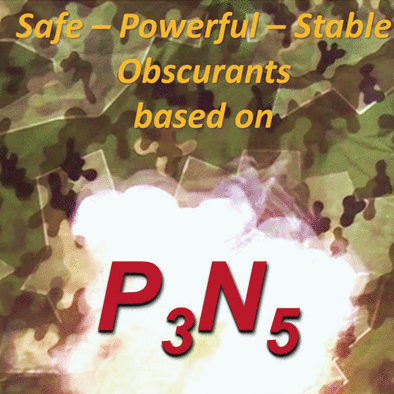|
Journal
Angewandte Chemie International EditionMore Press Releases related to this journalEditor: Neville Compton, Deputy Editor: Frank Maass. Editor Emeritus: Peter Gölitz
Print ISSN: 1433-7851 Online ISSN: 1521-3773
Published on behalf of Gesellschaft Deutscher Chemiker

|
Media Toolkit
Contact the publicist:
Mario Mueller[email protected]
|
Safe Fog: Phosphorus nitride could be used as a friction-stable, fast-burning, and very effective pyrotechnic obscurant
Safety combined with power and effectiveness is one of the most important targets in the development of pyrotechnic obscurants. In the journal Angewandte Chemie, German and Polish scientists introduced phosphorus nitride as a safe but very powerful alternative to the well-known red phosphorus formulations, which have been used in military and civilian applications for decades.

Obscurants fulfill a prominent role in military applications. An obscurant smoke is an aerosol cloud suddenly brought into the line of sight between an observer and a target. The most prominent source for pyrotechnic obscurants is still powdery red phosphorus, although it suffers from quite unsafe handling and a relatively sluggish burning with the possible release of toxic phosphine. Ernst-Christian Koch at Lutradyn-Energetic Materials Science & Technology and Stanisław Cudziło at the Military University of Technology in Warszawa (Poland) have now proposed phosphorus(V) nitride as a safe and effective replacement for red phosphorus.
At ambient temperature, phosphorus(V) nitride, P3N5 is a crystalline powder. Its performance was examined in typical pyrolant formulations, that is, mixed with an oxidant such as potassium nitrate. Upon ignition, which means under excessive heat and air, the phosphorus sublimes and undergoes combustion into its oxide, which serves as the actual aerosol-generating machine by taking up large amounts of water from atmospheric air. The resulting smog of phosphoric acid and water microdroplets will then conceal whatever should be taken out of sight.
The scientists reported three main advantages of phosphorus(V) nitride over red phosphorus. Firstly, the nitride burned fast. "The burn rates are two orders of magnitude greater then those obtained with state-of-the-art red phosphorous / potassium nitrate based pyrolants," said the authors. Secondly, it does not hydrolyze to highly toxic and flammable phosphine. Thirdly, and most importantly, it is resistant to friction. "Phosphorus(V) nitride is safe to handle with a range of oxidizers including chlorates, perchlorates, and nitrates," said the authors. Thus, differently from red phosphorus, there should be no need to add vast amounts of protective fillers like graphite to the formulation.
Notably, phosphorus(V) nitride as a commercial compound has no large-scale application yet. With these revelations on its possible use as a highly effective obscurant, this situation might be about to change.
(2593 characters)


